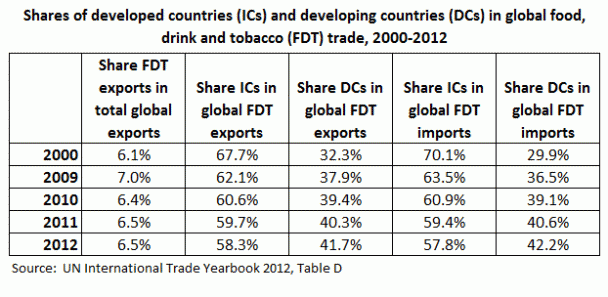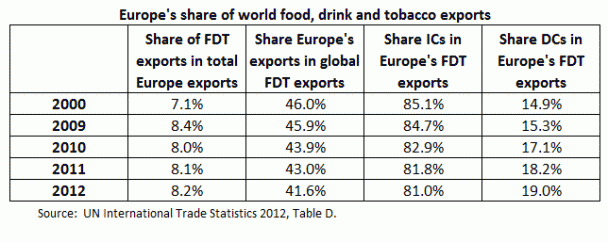Publication of the latest United Nations International Trade Statistics Yearbook with comparative figures from 2000 to 2012 gives an insight into the important structural changes in patterns of global agrifood trade over the past decade. The figures underline the way in which developing countries have become the dynamic motor behind agrifood trade flows, a finding which has relevance when discussing the coverage of WTO trade rules.
During this period agrifood trade maintained and even increased its share of total merchandise exports. It share was 6.1% in 2000, but increased to 7.0% in 2009 following the sharp rise in global food prices in 2008-09. Its share has subsequently fallen to 6.5% in 2012, which is still ahead of the 2000 figure.
The UN figures define agrifood trade as the food, drink and tobacco (FDT) items covered by Chapters 0 and 1 in the Standard International Trade Classification (SITC). This definition excludes agricultural raw materials (SITC 22) as well as oilseeds and oils (SITC 4) but it does include fish (SITC 03). Importantly, the figures include intra-EU trade as each country is treated as an individual reporter.
The figures show significant changes in the sources of global agrifood exports and imports. Imports in the table below are treated as the mirror image of exports, meaning that global exports to developing countries are assumed to be the same as global imports by developing countries. In practice, the UN trade database system COMTRADE also separately reports imports by each country, and there are often significant differences in detail between a country’s imports and the mirror exports from its trading partners. However, at this aggregate level using this shortcut is not likely to distort the underlying trends.

For example, developed (industrialised) countries remain the more important global FDT exporters but their share of global exports has fallen by almost 10 percentage points over this period. The share of developing country exports has increased by a corresponding amount, and they now account for almost 42% of global FDT exports (including agricultural raw material and oilseeds would increase this share further). The changes have been even more rapid on the import side, where the share of developed countries has fallen from 70% to 58% and the share of developing countries has increased from 30% to 42%.
The role of developing countries in driving the growth in agrifood exports and imports is shown more clearly by looking at their importance in the changes in trade over this period. In 2000, developing countries accounted for 30% of global FDT exports. Over the period 2000-2009 their share of the growth in exports was 42% and in the period 2009-2012 they accounted for more than half of all growth in exports (53%).
On the import side, developing countries accounted for one-third (32%) of global FDT imports in 2000. In the period 2000-2009 they accounted for 42% of the growth in global imports, and in the 2009-2012 period their share jumped to 59%. Developing countries thus now account for over half of both the growth in agrifood exports and imports. Comparing their shares of exports and imports in any year shows that that they have turned from small net exporters (as a group) in 2000 to small net importers (as a group) in 2012.
Developing countries are also increasingly trading with each other. In 2000, 57% of developing country exports went to the developed countries, and just 43% to other developing countries. In 2012, these shares were reversed. Now, only 39% of developing country agrifood exports go to developed countries, and 61% go to other developing countries.
The statistics also reveal the importance of agrifood trade for Europe. Europe in this UN classification covers the EU-27 including Iceland, Norway and Switzerland but excluding Bulgaria and Romania which are counted as developing countries. Agrifood exports are slightly more important for Europe than for the world as a whole. Striking is the importance of European exports (including to other European countries) in a global context. They accounted for almost half of global agrifood exports in the 1990s, and still account for more than two-fifths in 2012. Most of Europe’s agrifood exports go to other industrialised countries (much of this is intra-EU trade) but the share of developing countries has been growing, and now accounts for just under one-fifth of the total.

Implications for WTO trade negotiations
There is an important policy consequence of these shifts in the origin and destination of agrifood trade. Developed countries still dominate global agrifood trade flows with 60% of the total, but developing countries are becoming more important players and now account for 40% of the total. Indeed, if intra-EU trade is excluded and the EU were treated as a single trader, developing countries would now account for the majority of global trade in agrifood products.
Much of the debate on trade rules for agriculture inside the WTO calls (rightly) for disciplines on developed country agricultural policies but increased ‘policy space’ (meaning the right to use trade-distorting policies) for developing countries. The assumption is that the exercise of policy space by developing countries does not have negative spillover effects for other countries or, if it does, that any adverse effects will be primarily at the expense of the developed countries.
The latest UN figures show that this is no longer true. Farmers in developing countries are now increasingly likely to be the ones adversely affected by the trade-distorting policies of other developing countries. Developing countries have just as much to gain from ensuring that WTO disciplines on trade-distorting support and trade barriers apply both to developed and developing countries, while acknowledging that there is room for a fairer and more targeted application of those rules.
Most trade-distorting support to farming continues to be provided by developed countries, and the reduction of this support must remain the priority in the WTO Doha Round negotiations. But support in developing countries is growing rapidly, and it is not in the interests of other developing countries to ignore this.
These considerations were behind the discussions on food security at the recent Bali WTO Ministerial Conference. WTO members agreed at Bali to negotiate a permanent solution for the issue of public stockholding for food security purposes over the next four years. These rules will apply increasingly to trade among developing countries themselves.
Picture credit: Healthy Mountain Communities

Europe's common agricultural policy is broken – let's fix it!
